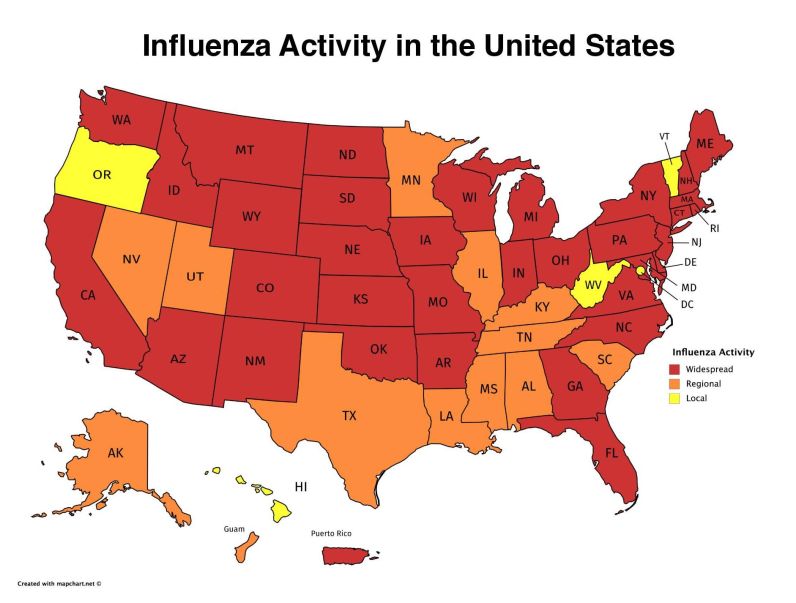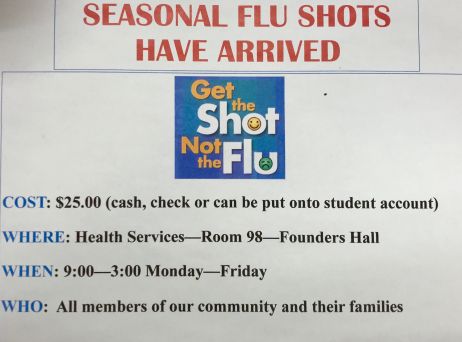
The peak of flu season may have passed, but the epidemic is far from over.
The Center for Disease Control and Prevention has rated this year’s flu as “widespread” in 49 states, the most prevalent the virus has been in that many states at once in 10 years.
Flu activity this season began to increase in early November and rose sharply from December through early February.
As of March 3, reports of the flu remained geographically widespread in 34 states, down from 45 the week before, and the virus was causing high levels of illness in 21 states, down from 32, the CDC said.
In the United States, the annual vaccination against seasonal influenza is recommended for all persons ages six months and up. The best time to get the flu shot is before the epidemic strikes, typically around November or December, but it is never too late to get the vaccine, for it can still prevent illness outside of the peak flu season.
“There’s still time to get vaccinated,” Dr. Arnold Monto, a professor of epidemiology at the University of Michigan School of Public Health, said in an interview with The Cut. “It would have been better to get it early, but the vaccine not only contains this subtype— but other subtypes which might continue spreading until April.”
It takes about two weeks after vaccination for antibodies to develop in the body that protect against flu.
In general, the illness can last four to five days, but the cough can unfortunately linger for weeks. And beyond that, it can take a while to fully snap back from the flu, since “It really is debilitating, especially if you have a full-blown case,” Monto said.
Ultimately, people are usually only contagious for five days at the most. The doctor recommended staying home from work for three to five days if a person is sick.
The CDC estimates that the flu has resulted in between 9.2 million and 35.6 million illnesses each year in the United States. With several more weeks of elevated influenza activity anticipated this season, it is too early to assess overall severity of the season.
“This has been a more active flu season than the past few years. I would compare it to the last high activity season of 2009-2010, which was the year of H1N1,” Susan Fitzgerald, the director of student health services at Cabrini, said.
One reason this strain is so widespread this flu season is that there may be a lower immunity to influenza A, which is the predominant strain of influenza found in cases this season – than other strains in the general population.
Flu vaccines have been updated to better match circulating viruses. During this flu season, the overall adjusted vaccine effectiveness against influenza A and influenza B virus infection was 36 percent, according to the CDC.
“Flu vaccine is made a full year before the actual season and identifying the predominant strains that will be causing sickness is a scientific challenge,” Fitzgerald said. “Even if the vaccine does not cover a circulating strain as well as we would like, it may lessen symptoms or reduce the duration of illness.”
This flu season has been a reminder that the world needs better flu vaccines, federal health officials said in a recent Congressional hearing.
“Ultimately, developing a universal influenza vaccine that provides protection against many different strains of flu from year-to-year would be ideal; however, the reality of such a vaccine is likely to still be many years away,” Food and Drug Administration Commissioner Scott Gottlieb said in prepared remarks to the House Energy and Commerce Committee.
The flu can be a deadly illness. In recent weeks, another five children have died from the influenza virus, bringing the total to 119. The CDC does not keep an exact count of adult flu deaths, but says more than 50,000 can die in a severe season like this one.

“Having the flu was one of the worst weeks of my life,” junior education major, Effie Soldatos, said. “I got the flu at school during my freshman year and it took so long for me to feel good again. I have gotten the flu shot ever since then, so I don’t have to suffer through that illness again.”
The flu virus is spreading all over a college campus. To avoid catching or spreading the virus, be sure to wash your hands, avoid sick people and stay home when you re sick. One way to avoid getting the flu or limit the intensity of the virus is to get the flu vaccine.
Students can still get their flu shot on campus by visiting the nurse.
“Health Services has a few doses of flu vaccine left. No appointment necessary and the $25 cost can be put on a student’s bill with a receipt provided if the student wants to submit to their insurance carrier for possible reimbursement.”


